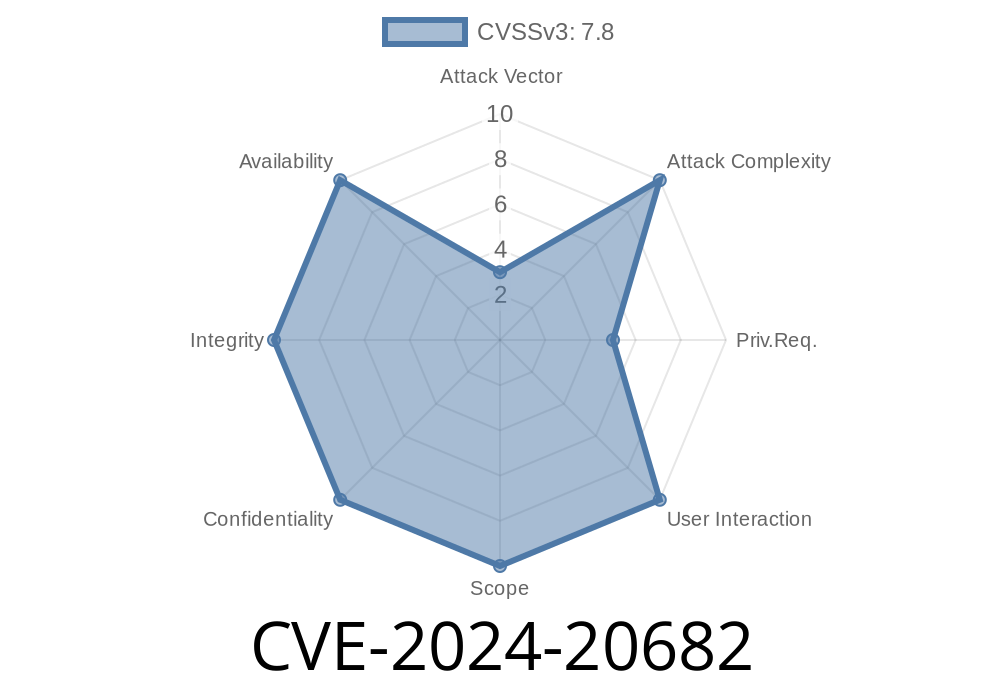The Common Vulnerabilities and Exposures (CVE) project has identified a serious vulnerability in the Windows operating system that affects the Cryptographic Services that maintain a secure computing environment. The vulnerability, CVE-2024-20682, is a remote code execution vulnerability that could potentially allow an attacker to gain unauthorized access to a computer and gain control over it. In this long-read post, we'll uncover the details of this vulnerability, explain the code snippet involved, provide links to original references, and discuss the exploit details.
CVE-2024-20682 Vulnerability Overview
The CVE-2024-20682 vulnerability exists in the Windows Cryptographic Services that provides encryption and decryption services for the Windows operating system. This vulnerability can be exploited when an attacker sends a specially crafted request to the vulnerable server that could ultimately result in remote code execution. If successfully exploited, this vulnerability can lead to unauthorized access to sensitive data or even total system compromise.
According to the CVE project's description of the vulnerability, CVE-2024-20682 can be exploited on several Windows operating systems, including Windows 10, Windows Server 2016, and Windows Server 2019. Microsoft has acknowledged the vulnerability and provided a security update to address the issue. The official reference (link) to the vulnerability can be found here:
Microsoft Security Advisory
Code Snippet
The vulnerability exists in the HTTP protocol used by the Windows Cryptographic Services. When processing a malicious HTTP request containing specially crafted parameters, this vulnerability can be triggered, causing a remote code execution. Here is a simplified overview of the request:
GET /CryptoService/?param1=malicious¶mN=malicious HTTP/1.1
Host: vulnerable.server.com
User-Agent: ()
...
In the code snippet above, the attacker sends a GET request to the vulnerable server's Cryptographic Services endpoint containing malicious parameters. When the server processes the request without properly validating and sanitizing these parameters, the vulnerability can be exploited.
Exploit Details
In order to exploit the CVE-2024-20682 vulnerability, an attacker needs to have access to a vulnerable Windows operating system and the ability to send a specially crafted HTTP request. This can potentially be achieved through various attack vectors, such as phishing emails containing malicious links or even by exploiting other vulnerabilities in a target environment.
Once the attacker has successfully exploited the vulnerability and gained remote code execution, they can potentially execute arbitrary commands on the compromised system and ultimately gain full control over the affected computer. This allows the attacker to access sensitive information, manipulate data, or even use the target computer for further nefarious activities such as launching additional attacks on other systems.
Recommendations and Remediations
Microsoft has released a security update to address the CVE-2024-20682 vulnerability, and users are urged to apply the update as soon as possible to reduce the risk of exposure. The update can be downloaded from the following link:
Microsoft Security Update
Regularly updating all software and operating systems to the latest versions.
2. Ensuring that network security policies and firewalls block unauthorized access to the Cryptographic Services endpoint.
3. Educating employees on the importance of vigilance when clicking on links in emails, even when they appear to be from trusted sources.
Closing Thoughts
The CVE-2024-20682 vulnerability is a serious security threat that could potentially allow an attacker to gain full control over a targeted system. By understanding the details of this vulnerability, including the code snippet involved and the exploit details, we can be better prepared to defend our systems against such threats. It is essential to remain vigilant and ensure that all necessary security updates are applied to minimize the risk of exploitation.
Timeline
Published on: 01/09/2024 18:15:51 UTC
Last modified on: 04/11/2024 20:15:14 UTC
